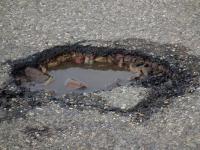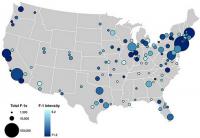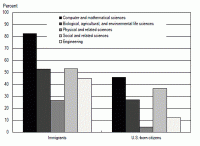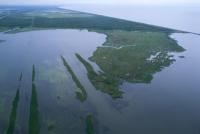-
Repairing earthquake-damaged bridge columns in days, not weeks
In just thirty seconds, a devastating earthquake like the ones that struck Japan and Ecuador can render a city helpless. With roadways split and bridges severely damaged, residents and emergency personnel could be prevented from moving around to rebuild. Normally, it takes weeks to repair the cracking or spalling of columns on just one bridge damaged in an earthquake. Researchers have developed a new process of fixing columns that takes as little as a few days.
-
-
Microwave repairs might annihilate zombie potholes once and for all

Some potholes are like zombies – they never die. Or at least that’s the perception of much of the driving public, especially as we enter peak pothole season: late winter and early spring. Recurring “zombie” potholes are too often a reflection of the type of method that’s used to patch or “fix” them – many of which are short-lived and only marginally effective. Researchers around the world are working to develop better and longer lasting repair alternatives. Microwave technology is not yet a routine method of repair, and it’s best-suited for potholes in asphalt rather than concrete. But this approach merits further consideration. After all, given our nation’s aging network of roads, zombie potholes will continue to flourish. Microwave repair could be an effective method for keeping them at bay.
-
-
New rule permits STEM graduates to stay in U.S. for 36 months

A new rule published by DHS this week allows foreign students in science and technology to extend their stay in the United States under the Optional Practical Training (OPT) program. The new rule will go into effect in May, and it will allow STEM graduates to stay and work in the United States for up to thirty-six months.
-
-
Four African innovators selected for engineering innovation prize
Following an open, competitive, application process which saw entries from fifteen countries in sub-Saharan Africa, twelve African entrepreneurs were chosen to receive a package of six months of business training and mentoring from the U.K.’s Royal Academy of Engineering. The four finalists showing the greatest promise have now been chosen, and are in with a chance to become the overall winner. Each will receive at least £10,000 with the grand prize of £25,000 to be awarded at a ceremony in Cape Town on 1 June. A low-cost sustainable water filter system to provide clean and safe drinking water, and a service that allows African mobile phone users to switch easily between multiple mobile networks are among the four African innovations selected by the Academy.
-
-
Immigrants play growing role in U.S. science and engineering (S&E) workforce
Immigration is a significant factor in decade-long growth in total science and engineering (S&E) workforce. From 2003 to 2013, the number of scientists and engineers residing in the United States rose from 21.6 million to 29 million. This 10-year increase included significant growth in the number of immigrant scientists and engineers, from 3.4 million to 5.2 million. Immigrants went from making up 16 percent of the science and engineering workforce to 18 percent.
-
-
Immigrants account for a larger share of U.S. science and engineering workforce

From 2003 to 2013, the number of scientists and engineers residing in the United States rose from 21.6 million to 29 million. An important factor in that increase: over the same time period, the number of immigrant scientists and engineers went from 3.4 million to 5.2 million. Immigrants went from making up 16 percent of the science and engineering workforce to 18 percent, according to a new report.
-
-
Restoring and sustaining Louisiana’s eroding coast

Measures taken over the last ninety years to prevent a repetition of the 1927 New Orleans flood — the construction of improved levees, spillways, and dams as well as associated flood and additional navigation management structures designed to contain overflows and manage and stabilize a deep-water channel – have starved adjacent wetlands of the freshwater and sediment needed to stave off the Gulf of Mexico’s rising tides. The resulting land loss across the Delta is leading toward catastrophic collapse. Over the last century, almost 1,900 square miles of deltaic wetlands, an area approximately the size of Delaware, have disappeared from Louisiana. Every hour, a football field-sized swath of land drowns in the Gulf’s advancing tides. A Louisiana independent initiative, with the support and participation of the State of Louisiana and U.S. Army Corps of Engineers, has called on experts from the private sector to develop and assess new designs for the Lower Mississippi River (below New Orleans). The winning proposals were announced last week.
-
-
Students race robot submarines in RoboSub competition
High school and college engineering students from across the globe competed for bragging rights and cash prizes at the 18th International RoboSub Competition, which wrapped up 26 July. The mission theme for this year’s contest played on the theme of the “Back to the Future,” movie trilogy. The individual autonomous underwater vehicle (AUV) had to navigate and complete an obstacle course — with tasks like “check the flux capacitor” and “travel through the time portal” — without human or computer interaction by team members.
-
-
Safer structures to withstand earthquakes, windstorms
A new cyberinfrastructure effort funded by a $13.7 million grant from the National Science Foundation will help engineers build safer structures that can better withstand natural hazards such as earthquakes and windstorms. Researchers aim to build a software platform, data repository, and tools that will help the United States design more resilient buildings, levees, and other public infrastructure that could protect lives, property and communities.
-
-
ONR helps at-risk, underrepresented youth prepare for STEM opportunities
Bureau of Labor Statistics data suggest that the U.S. economy will annually create 120,000 new jobs requiring a bachelor’s degree in computer science by the end of the decade. However, only 51,000 degrees in that field are awarded each year. An innovative program sponsored by the Office of Naval Research (ONR) will open the door to professional career opportunities for at-risk and historically underrepresented youth through training in the fields of science, technology, engineering, arts, and mathematics (STEAM).
-
-
NYU School of Engineering “Summer of STEM” launched
The third annual Summer of STEM is emerging as the most ambitious by far for the New York University Polytechnic School of Engineering: Reaching some 1,100 K-12 students and teachers as well as college instructors, it is offering the skills and excitement of science, technology, engineering and mathematics through twenty different programs.
-
-
"Keeping America a technological leader": SRC's STEM-supporting initiatives
SRC, Inc., an R&D company which was established in 1957, has its roots in academia. It regards science, technology, engineering & math (STEM) as the foundation of its business. Over the past decade there have been numerous reports about how the U.S. ranking in science and mathematics education has been declining. There has also been a drop in the number of students majoring in STEM fields. Around 2007, SRC developed its philanthropic focus areas as a way to direct its resources to areas where the company could have the most impact. One of these focus areas is STEM. HSNW talked with Lisa D. Mondello, director of corporate communications and PR at SRC, about the company’s STEM-related initiatives.
-
-
Our new anti-earthquake technology could protect cities from destruction
Protecting cities from earthquakes is still a grand challenge that needs addressing, as recent disasters in Nepal, Japan, Haiti, and Chile confirm. Although significant progress has been made in understanding seismic activity and developing building technology, we still don’t have a satisfactory way of protecting buildings on a large scale. This is a serious problem, since large numbers of buildings that don’t have built-in protection exist in earthquake zones, particularly in developing countries where replacing them or introducing stricter — and more expensive — building codes aren’t seen as an option. Researchers have designed a novel vibrating barrier (ViBa) to reduce the vibrations of nearby structures caused by an earthquake’s ground waves. The device would be buried in the soil and detached from surrounding buildings, and should be able to absorb a significant portion of the dynamic energy arising from the ground motion with a consequent reduction of seismic response (between 40-80 percent).
-
-
President Obama honors outstanding mathematics and science teachers
President Obama on Thursday named 108 mathematics and science teachers as recipients of the prestigious Presidential Award for Excellence in Mathematics and Science Teaching. The Presidential Award for Excellence in Mathematics and Science Teaching is awarded annually to outstanding K-12 science and mathematics teachers from across the country. “These teachers are shaping America’s success through their passion for math and science,” Obama said. “Their leadership and commitment empower our children to think critically and creatively about science, technology, engineering, and math. The work these teachers are doing in our classrooms today will help ensure that America stays on the cutting edge tomorrow.”
-
-
Bay Area students learn value of science, engineering through My Brother's Keeper initiative
It was an exciting day for more than sixty disadvantaged youth from Oakland, San Francisco, and Tracy, who visited the Lawrence Livermore National Laboratory on Friday for a special “Day at the Lab” as part of the White House initiative, My Brother’s Keeper. The My Brother’s Keeper (MBK) initiative was launched by President Barack Obama to address opportunity gaps with disadvantaged and disconnected youth, specifically targeting minority boys, to encourage positive future life and career choices. The goal is to connect young people to mentoring and support networks and to instill a passion for Science, Technology, Engineering, and Mathematics (STEM).
-
- All
- Regional
- Water
- Biometrics
- Borders/Immig
- Business
- Cybersecurity
- Detection
- Disasters
- Government
- Infrastructure
- International
- Public health
- Public Safety
- Communication interoperabillity
- Emergency services
- Emergency medical services
- Fire
- First response
- IEDs
- Law Enforcement
- Law Enforcement Technology
- Military technology
- Nonlethal weapons
- Nuclear weapons
- Personal protection equipment
- Police
- Notification /alert systems
- Situational awareness
- Weapons systems
- Sci-Tech
- Sector Reports
- Surveillance
- Transportation
Advertising & Marketing: advertise@newswirepubs.com
Editorial: editor@newswirepubs.com
General: info@newswirepubs.com
2010-2011 © News Wire Publications, LLC News Wire Publications, LLC
220 Old Country Road | Suite 200 | Mineola | New York | 11501
Permissions and Policies
Editorial: editor@newswirepubs.com
General: info@newswirepubs.com
2010-2011 © News Wire Publications, LLC News Wire Publications, LLC
220 Old Country Road | Suite 200 | Mineola | New York | 11501
Permissions and Policies
